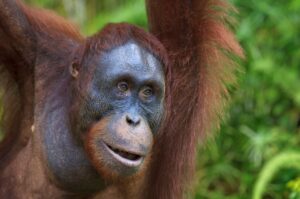A passion for the natural world drives many of our adventures. And when we’re not actually outside, we love delving into the discoveries about the places where we live and travel. Here are some of the best natural history links we’ve found this week.
Blood glaciers: Explorers have witnessed blood glaciers for centuries, but a new study shows that these algae blooms that turn snow pink are becoming much more common. The algae change color to protect themselves from ultraviolet light. The increase seems due to climate change. The rise in carbon dioxide levels, in particular, allows the algal blooms to thrive. However, blood glaciers will also melt more quickly because the red color no longer reflects the sun’s rays as well as pure white does.
Dinosaur footprints found in UK: Footprints of six different species of dinosaurs have turned up on the cliffs of Folkestone, UK. Storms exposed the long-hidden prints, which belonged to ankylosaurs, theropods, and ornithopods. The largest print was 80cm wide and 65cm long. Dating back 110 million years, these dinosaurs would have been some of the last to roam the UK.
A 21-tonne rhino
Prehistoric species of giant rhino discovered: Fossils of a new species of giant rhinoceros taller than a giraffe have turned up in northwestern China. The 26.5-million-year-old rhino weighed 21 tonnes (the weight of four African elephants) and reached a height of almost seven metres. This makes it one of the largest mammals to ever have existed. Fossils of giant rhinos are already familiar to paleontologists, but this was an entirely new species. It has also provided more information on the evolution of modern rhinos.

Reconstruction of giant rhinos. Illustration: Chen Yu
China sends astronauts to space station: On Thursday, China launched its first crewed space mission in five years. The three astronauts will spend three months at China’s new space station, carrying out experiments and preparing the site for future missions. The mission control team back on earth will also monitor the trio physically and psychologically. Eleven further missions over the next 12 months will continue building the station.

Ornithopod footprint. Photo: University of Portsmouth
A living fossil
Coelacanth can live for 100 years: It turns out that cocelacanths live longer than expected in more ways than one. Cocelacanths are giant fish that have been on the planet since the time of the dinosaurs. Everyone had thought the 400-million-year-old species was extinct until living specimens turned up off South Africa in 1938. At the time, research pegged their lifespan at 20 years, but it turns out that they can live for up to 100 years. Females do not reach sexual maturity until their late 50s, and their pregnancy may last up to five years. This so-called living fossil is so endangered that only dead or already captive specimens may be studied.
Satellite view of 2019 eruption to improve volcano monitoring: In 2019, clouds of steam and volcanic gases issued from the Whakaari volcano in New Zealand. This small explosion nevertheless killed 22 people and injured 25. High-resolution satellite data has revealed how the gases released by the volcano changed before, during, and after the eruption. This work shows that it’s possible for satellites to measure gas emissions before eruptions. This could allow warnings before eruptions, says volcanologist Jorge Andres Diaz of the University of Costa Rica.

A coelacanth in a museum in France. Photo: Christophe Archambault
Second lion at Indian Zoo dies of COVID: Two lions have now died from COVID-19 at a zoo in Chennai, in southern India. Both had undergone treatment for the infection since June 3 but succumbed to the virus within days of each other. The source of infection within the zoo is unknown, but at the end of May, five lions began exhibiting symptoms of the virus. Over the next few weeks, these numbers doubled. Experts are still treating the remaining eight infected lions.






